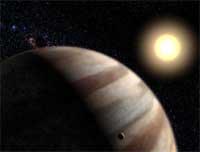They detect the atmosphere of an exoplanet

This exoplanet orbiting around the sun-like HD 209458 star is found in the constellation of Pegasus at 150 light-years from Earth. He first saw it in 1999 and claimed that Jupiter has 70% of its mass, that is, 220 times more than Earth. Many observations have been made through the Hubble telescope and the orbit has been defined. His closeness to his star makes him pass by every 3.5 days and in those moments decreases the brightness of the star. Thanks to this, they have discovered that, like Jupiter and Saturn, it is mainly in a gaseous state and that its temperature is about 1,100 C.
After analyzing four steps ahead of the star it is verified that it has atmosphere. In these four stages, the color of the light emitted by the star has been studied and, compared to the spectrum of the light that it normally emits, the presence of sodium in the atmosphere has been observed as in the surface of the planet. Now they want to try with other colors of the spectrum of star light, to see what filters the atmosphere of the planet. Thus, it is expected to detect methane, water vapor, potassium and other chemicals. In addition, the search for chemical traces of life will also be possible according to NASA.
Buletina
Bidali zure helbide elektronikoa eta jaso asteroko buletina zure sarrera-ontzian










